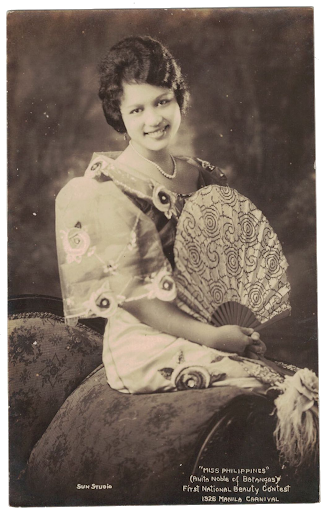
First Queens of the Philippines
History
August 3, 2020
Here's a closer look into the origins of Filipino pageantry.

Contemporary Filipino popular culture is laden with references to beauty pageants. Especially right now with 2018 Miss Universe Catriona Gray’s ubiquitous commercial endorsements and visual advertisements. Aside from Manny Pacquiao boxing matches, no other captivates the attention of the Filipino audience with nationalist fervor. In Fairest of the Fair curated by Inti Guerrero, the exhibition posits that this phenomenon. was a product from its colonial history. Photos of the first beauty queens in the form of memorabilia postcards of the Manila Carnival are juxtaposed with contemporary videos that looks into the impact of pageant culture and the spectacle of spectatorship, commodification, and objectification in today’s globalization era. The exhibition further arises conversation on the origins of the culture of pageantry in the Philippines, the significance of such to the Filipino culture, and the characterisation of a ‘Miss Philippines.’

Long before the first ever Miss Universe Pageant in 1952, with Miss Philippines Teresita Sanchez representing the country, the title of Miss Philippines had already been given annually to the winners of the National Beauty Contest of the Manila Carnival. It all began in 1908 when the first Manila Carnival or ‘Philippine Exposition’ was held at the Wallace Field in Luneta Park to celebrate US-Philippine Friendship. As it was one of the most famous and noteworthy events during the American period, it would garner visitors from all over the country. One of its key features was the election of a carnival queen that would reign for a year, meet with high officials in the government, and serve as the face of the carnival promoting all the industries that were exhibited.

The election of a carnival queen became so esteemed that in 1926, they changed the practice into a National Beauty Contest where the winner will be crowned as Miss Philippines and the runner-ups were named after represented regions including Miss Luzon, Miss Visayas, and Miss Mindanao. Similar to Binibining Pilipinas, candidates would come from all over the country and represent their province. In fact, some provinces would even hold smaller carnivals to elect a local queen who would then advance to the Manila Carnival. Town fiestas desire to have a queen such as the Rizal Day Queens.
Unlike today’s rigourous pageant training, candidates for the crown back then relied heavily on a woman’s upbringing, education, and social status. Newspapers such as the El Renacimiento would sponsor a candidate’s campaign to run for the crown. Many of the candidates were students, both highschool and college. In some instances, they would have to stop school for a short time to reign as Miss Philippines.
In spite of this, many of the queens were already well established and noteworthy, possessing the appeal of a ‘Miss Philippines.’ For example, Pura Villanueva Kalaw, the first Manila Carnival Queen in 1908, was already a well known beauty who was a Spanish writer for El Tiempo, a leading newspaper in the day. Another queen, Pacita “Paz” de los Reyes was a law student at the University of the Philippines when she represented her university for the third National Beauty Contest in 1929 and won the title of Miss Philippines.


In addition to this, many of the queens were also from prominent families with a distinguished lineage. Anita Noble y Agoncillo, who won the first “Miss Philippines” title in 1926, has direct relationships to Felipe Agoncillo, a diplomat of the First Philippine Republic, and Marcela Agoncillo, who sewed the first Philippine Flag. In fact, the title was tied between her and Carmen Fargas of Zamboanga. During the competition, President Manuel L. Quezon made an appearance to help the judges come to a resolution. Although she didn’t have a strong lineage as Anita, Carmen stood her ground and won a special title of “Miss Pearl of the Orient Seas.”

Since then, the title of Miss Philippines has become increasingly competitive, and the candidates do not only have to prove themselves as well-mannered but also very substantive and proactive. Indeed, these women embody traits of a Miss Philippines worthy of public following and acclaim. With the nation’s obsession with beauty queens and beauty pageants today, it is worth looking back at those who first stood as the country’s muses. This is not only for knowing how it began, but also to understand what kind of culture it set up and how it is deeply embedded in our lives today.
The persistence of the culture of pageantry is apparent today. Localised pageants have risen in popularity despite due to limited resources to join official tournaments. Many of the works in Fairest of the Fair exemplify this: Koken Ergun’s installation entitled “Binibining Promised Land” (2010) is a documentary of an overseas Binibining Pilipinas pageant organised by OFW’s in Israel and photojournalist Jose Enrique Soriano’s black-and-white film photos capture a beauty contest in the National Center for Mental Health in Mandaluyong, Metro Manila between 1991 – 1994. These works, juxtaposed with the images of the Philippines’ first beauty queens manifest the culture of consumerism and fetishism that carnivals and pageants induce. Not to mention the fact that the images of the carnival queens were printed as postcards or collectibles designed for sale in commemorations of events, places, and people.
REFERENCES:
Castro, Alex R. Aro katimyas da!: A Memory Album of titled Kapampangan Beauties (1908 – 2012). Holy Angel University: Center for Kapampangan Studies, 2012.
Katigbak, Maria Kalaw. LEGACY Pura Villanueva Kalaw: Her Times, Life, and Works 1886–1954. Makati: Filipinas Foundation, 1983.
Gonzales, Gino and Mark Lewis Higgins. Fashionable Filipinas: An Evolution of the Philippine National Dress in Photographs 1860 – 1960. Makati: Slim’s Legacy Project Inc., 2015.
Nuyda, Doris G. The Beauty Book. Manila: Mr. & Mrs. Publishing Co., 1980.
Bellas Artes Projects
2/F Victoria Towers
Panay Avenue cor. Timog Avenue
Quezon City 1103
info@bellasartesprojects.org
programmes and interesting events.
